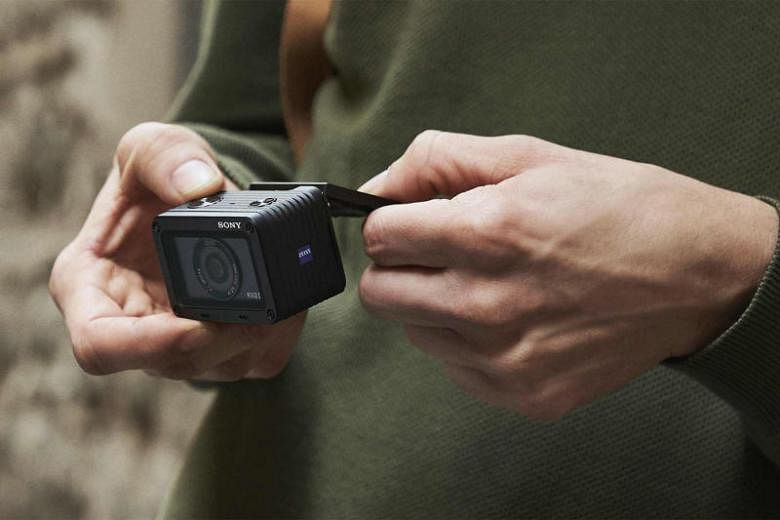The Sony Cyber-shot DSC-RX0 II makes a strong case for a dream camera for both action seekers and video bloggers.
For the action crowd, it packs toughness and is svelte. It is dust- resistant, water-resistant to a depth of 10m, shock-resistant against drops from up to 2m and crush- resistant against a force of 200kg.
All this in a camera measuring 59mm by 40.5mm by 35mm and that weighs 132g (with battery and microSD card).
For vloggers, it packs impressive imaging specs. They include a 15.3-megapixel image sensor, Sony's advanced Bionz X image processor and support for 4K 30p internal movie recording. It also has a 180-degree tiltable 1.5-inch display that is perfect for video blogging.
Its metallic rectangular body has two buttons on top - for power and shutter release respectively. At its bottom is a standard tripod mount socket.
In front, a protective glass protects its 24mm f/4.0 lens, which provides a viewing angle of 84 degrees. With this viewing angle, you will not get distortions in stills and videos, which is a problem with the 170-degree viewing angle of its competitor GoPro Hero7.
On the RX0 II's rear, there is a compartment on the left of the display that houses a microSD card slot, a micro-USB port, a micro-HDMI port and a 3.5mm microphone input jack.
-
FOR
- Compact and lightweight
- Solid build
- Microphone input jack
- Flippable screen ideal for vloggers
- Great image quality
AGAINST
- Not cheap
- Menu interface, which should have been be re-designed for its small screen
- Short battery life
-
SPECS
PRICE: $899
IMAGE SENSOR: 15.3-megapixel 1-inch CMOS
DISPLAY: 1.5-inch tiltable LCD with 230,400 dots
LENS: 24mm f/4.0
SENSITIVITY: ISO 80 to 12,800
SHOOTING SPEED: Up to 8 frames per second
WATER RESISTANCE: 10m
WEIGHT: 132g (with battery and microSD card)
-
RATING
FEATURES: 4/5
DESIGN: 4/5
PERFORMANCE: 4/5
BATTERY LIFE: 2.5/5
VALUE FOR MONEY: 3.5/5
OVERALL: 4/5
On the right of the display are the up/down buttons and a function button. A menu button and the left/right buttons sit at the bottom of the display.
As the menu interface is directly imported from other Sony cameras, it looks really small on the 1.5-inch screen.
Changing settings is also a hassle with the tiny buttons around the display. Sony should have re-designed the menu interface with bigger fonts and larger spacing.
To make things worse, there is no way to quickly change between the stills and video modes.
For shooting stills, you need to press the Menu button, select Camera Settings, go to Photo mode and press the shutter release button.
For video recording, you have to do the same except you go to the Video shoot mode before pressing the shutter release button to start recording.
I feel there should be dedicated buttons for photo taking and video recording.
However, Sony does have a solution. Its optional VCT-SGR1 shooting grip ($139) has dedicated photo- and video-record buttons that are easily accessible with your thumb.
In any case, I highly recommend getting this grip, which is comfortable to hold and doubles as a mini tripod. The only downside is that to use it, you have to open the RX0 II's rear compartment and insert the micro-USB cable from the grip to the camera's micro-USB port.
Operation-wise, the RXO II is pretty swift. It takes two seconds to power up and a second to shut down.
Autofocusing (AF) is almost instantaneous under good lighting conditions with its Eye AF working hard to make sure your subject is in focus. Under dim lighting conditions, it does take more than two seconds to secure a focus.
For video recording, it is able to track a subject quickly while keeping it in focus.
Still image quality is great - with natural skin tones and crisp details - for a camera this small. But this camera is all about videos and it does not disappoint.
Be they 1080p or 4K in resolution, videos are sharp, with the built-in microphones picking up voices distinctly.
The image stabilisation is also quite smooth, though not as smooth as that of the Hero7.
Image noise performance is not particularly good. I can see clearly noise artefacts and distinct detail loss from ISO settings as low as 800.
This becomes a problem when you want to shoot indoor slow- motion videos, which the RX0 II is capable of at 1,000 frames per second.
The footage I get areso grainy that they are hardly usable. I recommend shooting slow-motion videos only in bright sunlight.
Perhaps the biggest disadvantage is its price tag. The Hero7 is priced at $595, while the RX0 II is close to $900. Furthermore, its 35-minute battery life pales in comparison with the Hero7's two-hour battery life.


